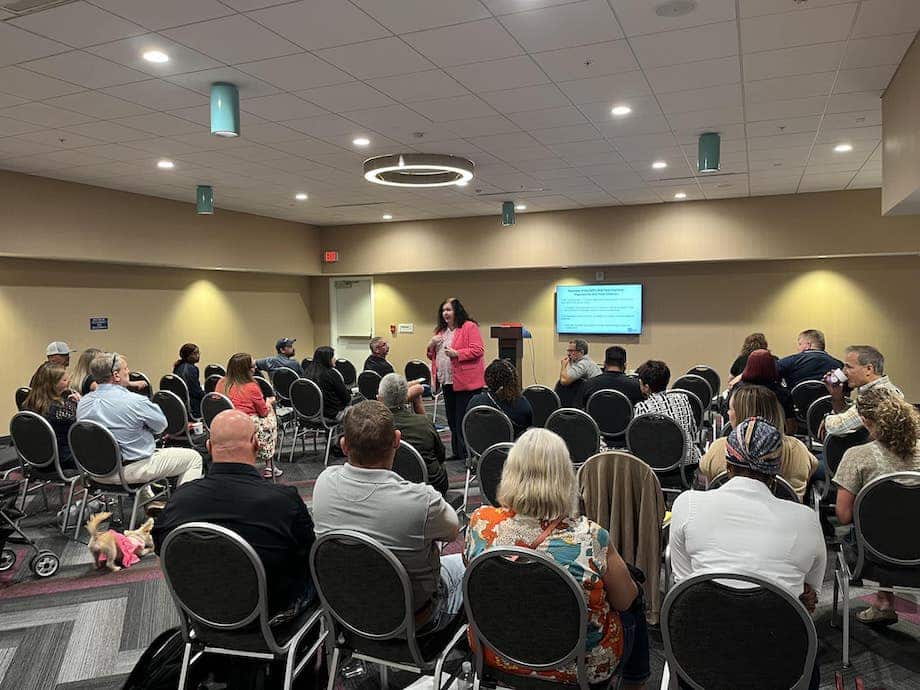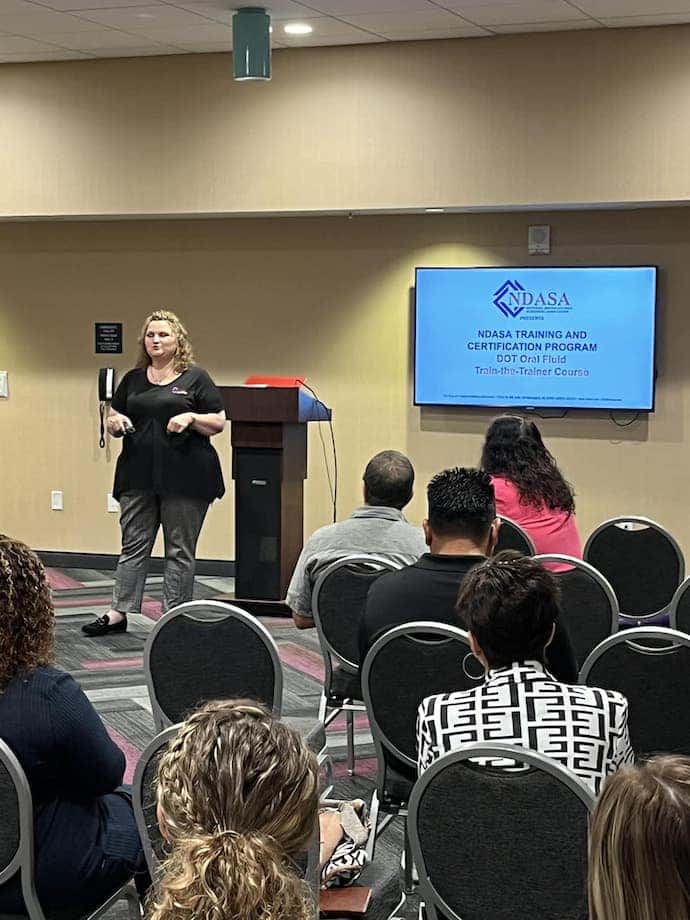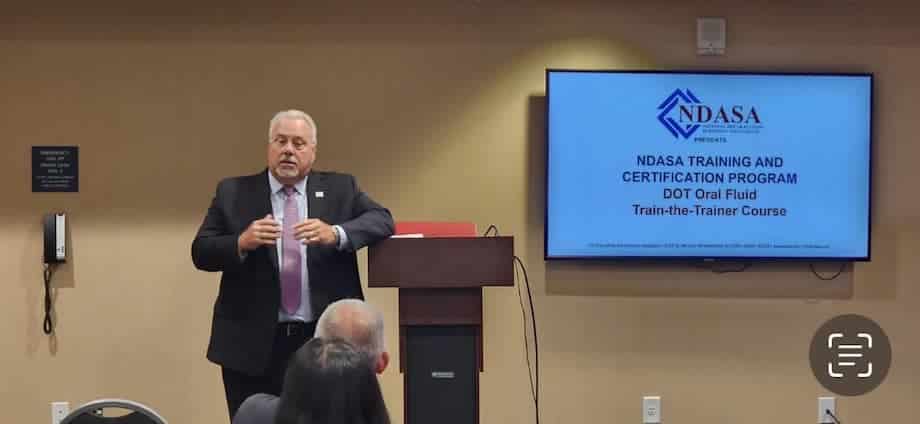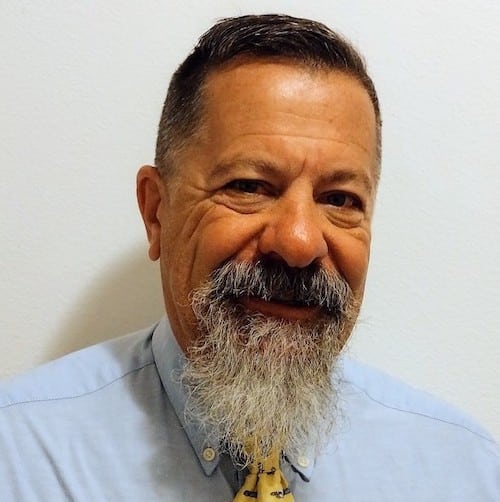Anthony (Tony) Sassano, Trainer and Consultant for National Drug Screening reports on his recent attendance at the National Drug and Alcohol Screening Association (NDASA) DOT Oral Fluid Train-the-Trainer Course.
On September 7, 2023, I attended the DOT Oral Fluid Train-the-Trainer Course that was presented by NDASA in Orlando, Florida. The two main NDASA presenters were executive director Jo McGuire, and their senior policy executive advisor, Patrice Kelly. The course was intended to provide a training certificate and guidelines for Oral Fluid trainers. Below is a summary of the course offering, which is mainly a recap of their slideshow. Much of the information has already been disseminated throughout the industry.
The DOT approved Oral Fluid testing, effective June 1st, 2023, as described under 49 CFR Part 40 (Part 40) and Subparts C, D, E, I and R; ODAPC interpretations and Q&A; and DOT Oral Fluid Specimen Collection Guidelines. NDASA approved trainers must be familiar with rulings and guidelines and be certified by an industry association – or – have been a collector of DOT regulated fluid tests for one year (which is not available yet since we are at the inception of Oral Fluid testing). Certification is valid for 5 years.

NDASA will be providing training materials for future reference and a Model Standing Order. NDASA PowerPoint and Documents must never be altered. Companies can include their own logos in the documentation, but the content must not change. Primarily it was emphasized that Standing Orders be in place at each collection site that direct the collectors on the preferred collection method for various circumstances they may encounter. Standing orders are provided by the employer to specify under which circumstances the DOT drug test is performed using urine or oral fluid. Also, as a side note, clinics are now required by law to have a direct phone line to the collectors and/or supervisor. Calls to specific clinics cannot be routed to a call center.
The course discussed training collectors in the proper environment, such as ensuring that you have adequate seating and materials. The trainer must also “read” the students to ensure that they understand the material being taught and encourage active participation. They used an acronym, MARS as a guideline: (M)motivation – motivate your students by expressing the importance of this DOT requirement; (A)association – associate Oral Fluid testing with how it is similar with their current tasks; (R)repetition/Practice – encourage repetitive practice to gain familiarity with the entire process; (S)sensory Perception – have students observe and participate in the actual learning process so they can get a better feel for the processes.
The industry is currently waiting for the HHS to approve two testing labs and approval of the test collection kits. It is possible that different labs will use different test collection kits. Collectors will need to be certified on how to use each type of test kit that they will be using. Test kits will be needed for the mock collections. NDASA has asked the labs to develop reusable mock test kits to help mitigate the cost of training supplies.
After discussing the major components of the policy, the presenters discussed the oral fluid testing itself, and its advantages over urine testing . The average person produces 0.5 to 1.5 liters of saliva (oral fluid) per day. So, the chances of a person having a dry mouth are very small compared to the chances of having a shy bladder. Drugs cross over from the bloodstream and into the saliva, allowing for their detection. Oral fluid drug detection has a shorter window of detection than urine testing does. This is beneficial to ensure that the person may have recently taken drugs at the time of the testing.
Oral fluid testing is very convenient to administer in any environment. There is no need for specific enclosures allowing for greater flexibility for on-site collectors. Since oral tests are always observed, there is far less chance of receiving adulterated samples. Oral testing also eliminates gender issues with direct observations. The positive rates for oral testing are higher than that of urine testing. Oral fluid testing also eliminates much of the wait time in case there is a shy bladder.

The collection technique will most likely involve placing a cotton swab in the mouth to attain the saliva or by providing the sample directly into a vial. The industry is still awaiting approval of a collection device. Devices must be of single use and capable of being subdivided in presence of the employee for a split specimen. Shipment, testing and reporting results will be much the same as urine testing under the chain of custody. The drugs tested will remain unchanged; Marijuana, Cocaine, Opioids, Amphetamines, and Phencyclidine.
Again, they emphasized that employers issue Standing Orders to explicitly detail an employer’s choice for urine and oral testing. It should state when to use oral and/or urine testing.
For refusals at the collection site, it remains the employer’s responsibility to determine if a refusal had actually occurred. The TPA or C/TPA may make this decision if the donor is also an owner operator.
It is important for collectors to check and verify the expiration date of the test kits. On the CCF, the collector must check the Oral Fluid box and the “Each Device Within Expiration Date?” box under Step 2. Test kits cannot be used after their expiration date… it will be a fatal flaw if they are. The collector must write the expiration date on the CCF where it says, “Split Specimen Device Expiration Date.”
For DOT agencies other than FMCSA, employers may use a Social Security Number, a unique employee ID, or any State/Federally issued ID like a driver’s license. A CDL number and the issuing state must be used for FMCSA regulated employees.
Collectors must put their phone number and/or supervisor’s number on the CCF – the number cannot be a call center as stated earlier.
If the standing order calls for oral testing in the event of a shy bladder for example, and the collection site does not offer both urine and oral testing, a collector must work with the employer to have the employee transported to another collection facility. The collection cannot be terminated.
Direct observation urine collection will no longer be performed for transgenders and nonbinary individuals. Only oral collections are permissible in this situation.
All DOT agencies can use Oral Fluid testing.
In summary, all collectors must be knowledgeable about 49 CFR Part 40, keep current about DOT Oral Fluid Specimen Collection procedures and subscribe to the ODAPC list-serve.
Collectors must undergo error correction training within 30 days if they have a fatal flaw causing test to be canceled. Specimens damaged during shipping no longer cause a fatal error and are not the responsibility of the collector.
The list of supplies that should be included during a training course are; Sample CCFs to be filled out, collection devices (6-7 per trainee), specimen vials, collection instructions, tamper evident seals, specimen bag, shipping supplies, drinking water (8 oz in a sealed bottle), a timing device (I have personally used my phone with a timer app when doing COVID testing.), and paper towels.
Best Practices Procedures should also be followed; Use a flashlight or phone to inspect the donor’s mouth, use single-use gloves, and use hand sanitizer. Collection sites must be secure to prevent unauthorized access to testing materials and to ensure the privacy of the donors.
Before beginning the training sessions with trainees, allow them to see the instructions and checklist for the oral fluid collections and the checklists for the mock proficiency demonstrations. The monitor for the mock collections must also complete the checklist. Another trainee can complete the checklist and be the monitor for the mock collections if they are a qualified collector and have taken the train-the-trainer course – or – if they have had one year of collections experience.
After the HHS approves a primary and secondary lab, collector trainees will need to complete 5 error-free mock collections on each device they intend to use. They must also sign and retain the collector agreement – Important – It is important to retain the CCFs from mock collections because some DOT agencies will inspect these CCFs. Trained collectors must receive their credentials and register in the list of Professional Collectors with NDASA.
The instructors then went over the steps of collecting the oral fluid specimen; Do an alcohol breath test first if it is scheduled; collect a specimen from only one donor at a time; review the employer’s standing order, ensure the collector’s contact information is on the CCF; ensure the DER name and number is on the CCF; identify the donor through a valid form of ID.
Collectors must contact the employer if there is a conflict with the type of test ordered that may be incorrect for the reason ordered. Collectors cannot overrule the employers.
Collectors may ask donors to remove outer clothing such as jackets or hats if there is anything suspicious.

Collectors must be patient with donors but adhere to the testing protocols.
At the onset of the collection, the collector must identify the donor with a valid ID or contact the DER if no ID is provided. If the collector observes any materials brought into the collection site or if there is any attempt to alter the collection, the collector must terminate the collection, note the circumstances in the Remarks section of the CCF and report the situation to the DER. The DER must determine if the situation is a refusal to test.
The collector should inspect the inside of a donor’s mouth and make sure it is free of any items such as food or gum. The collector may use a flashlight. The collector then starts a 10 minute wait period and should fill out the CCF during this time. The collector must also provide the donor with a new specimen collection device that is sealed. The expiration date must be verified, then the device must be opened in view of the donor. Instruct the donor to use hand sanitizer or wash their hands. Keep the test kit in view of the donor from the time it is opened till the time the specimen is collected and sealed. The collector must remain in visual contact with the donor during the collection process. Any unusual behavior or appearance must be reported on the CCF. The collection must be terminated, and the DER notified if any attempt to alter the specimen is detected by the collector. The donor and collector must complete the specimen collection documentation in accordance with the manufacturer’s instructions. The collector must observe the donor positioning the specimen collection device for the device collection.
The collector is responsible for ensuring that the collection is done properly. If the donor is unable to provide a specimen, the collector must follow the procedures in Part 40 section 40.193. Once the specimen is collected, the collector must inspect it for any unusual color, foreign materials or any signs of tampering. If it is apparent that the collection has been tampered with, the collector must conduct a new collection. Any unusual characteristics must be documented. Once the specimen is collected and split, the collector will place a tamper-evident seal from the CCF over the cap of each specimen container. The collector must then write the collection date on the seals and the donor must initial each seal. If the employee declines to do so, the collector must make note of this in the Remarks line on the CCF.
The collector will then follow the manufacturer’s instructions to package the specimens for transport. Collectors must verify that a sufficient amount of specimen has been collected per the manufacturer’s requirements.
In the event of a dry mouth (very rare), the collector must follow the procedures outlined in 40.193; Give the donor 15 minutes of using the collection device; If a sample cannot be collected after 15 minutes, ask the donor to drink up to 8 ounces of water and then wait an additional 10 minutes before the next collection. It is good practice to note the added time and the amount of water drank by the donor to achieve a specimen in the Remarks line on the CCF. The donor may be provided up to 1 hour to provide a specimen. If the donor is unable to provide a specimen after one hour, the DER must be notified immediately, and the collection discontinued. These facts must be stated on the CCF.
Copy 2 of the CCF is sent to the MRO and copy 4 to the DER within 24 hours or the next business day.
Each collector must complete five error-free mock collections. These are required for each collection device and be administered in real life scenarios. They may be repeated until successful. The checklists must be retained by the collector and signed by the trainer and/or observer.
The trainer can act as the donor during the mock collection, or a 3rd person will be required whether in person or done virtually. Collectors must always explain each step that is required and act to de-escalate any conflict with the donor in a professional manner.
The National Drug and Alcohol Screening Association (NDASA) is the national association representing the drug and alcohol testing industry. NDASA provides a valuable online resource called The Town Hall. It is a weekly online meeting or forum where participants can ask questions concerning oral fluid testing and other drug testing industry topics.
In summary, these are the general guidelines for the oral testing procedure and requirements to become a certified oral fluid collector at this time. The procedures may change as manufacturers develop each of their test kits and/or as procedural issues are developed that may necessitate a change.
Anthony Sassano
Learn More About Oral Fluid Collector Training
Learn More About The National Drug and Alcohol Screening Association (NDASA)







